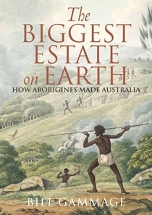The biggest estate on earth: How Aborigines made Australia by Bill Gammage

Allen and Unwin, 2011. ISBN 9781742377483.
(Age 15+) Highly recommended. 'To the people of 1788, whose landcare
is unmatched, and who showed what it is to be Australian.' 'The
people of 1788' are the Aborigines and the dedication is by
Professor Bill Gammage. His thesis is that the Australian landscape
as it was first viewed by Europeans was made by humans not by
nature.
The biggest estate on earth begins our journey of discovery by
looking at the landscape through the eyes of the European newcomers.
Why did they comment so often on the 'parks' and 'lawns' that met
their gaze? Why did their paintings show vistas of grassland where
now there are forests or thick scrub? Why did they report that
indigenous people deliberately set fire to the countryside?
According to the author, the newcomers did not recognise that the
land in which they had arrived was as closely managed as the one
they had left. The continent was a mosaic of inherited lands whose
traditional owners conserved precious water supplies, and used
controlled burning to prevent bushfires and create favourable
conditions for the plants and animals they wanted to harvest. A
belated appreciation of the value and complexity of sustainable
Aboriginal land management practices is now emerging. This
remarkable book may facilitate that process.
The writing style is precise and accessible and the organisation of
material assists both ease of understanding and the development of
the argument. However, the author knows that some people will
disagree with his conclusions. He has responded by revealing his
argument slowly through a wealth of documentary and pictorial
evidence, drawn from meticulous observation and scholarship.
Detailed descriptions are based on an evident love of Australian
plants, influenced perhaps by his botanist father.
Reading The biggest estate on earth requires patience but
the rewards are great. They include an insight into a vast store of
knowledge, now diminished but not entirely lost, and an
understanding of how this knowledge has been incorporated into
religious beliefs, culture and daily life.
Elizabeth Bor
Editor's note: The book was the winner, 2011 Manning
Clark House National Cultural Awards (Individual category).
Pat Pledger